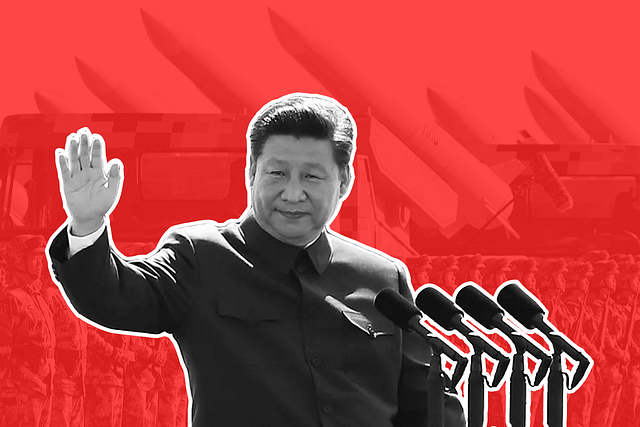Commentary
Is The Chinese Rocket Force A Paper Tiger?

Chinese President Xi Jinping.
Is the Chinese Rocket Force (PLARF), which operates China's entire arsenal of long-range strategic and short-range tactical missiles, and which plays a crucial part in China's defence strategy, merely a paper tiger?
Recent report in Bloomberg, citing US intelligence sources, have cast doubts over the integrity of this elite branch of the Chinese military.
The report says that the recent purge of high-ranking officials from the rocket force by Chinese President Xi Jinping, including former Defense Minister Li Shangfu, is linked to corruption within the People's Liberation Army Rocket Force (PLARF).
Accusations, such as filling missiles with water instead of fuel and issues with lids of ground-based missile silos, have raised serious questions about the PLARF's actual readiness and reliability.
The PLARF has its roots in the PLA Second Artillery Corps (SAC), which, until 2015, operated all of China's strategic long-range missiles.
On 31 December 2015, SAC was reconstituted as the PLARF, assuming command over all missiles, thereby integrating both nuclear and conventional missiles under a unified structure and elevating it to a level on par with other military branches, viz army, navy and air force.
According to a 2014 US government official report, the PLARF's missile inventory was already formidable, with nearly 1,895 missiles, including 1,000 to 1,200 short-range ballistic missiles (SRBMs), 75 to 100 medium-range ballistic missiles (MRBMs), 200 to 500 ground-launched cruise missiles, and another 100 to 120 intermediate-range ballistic missiles (IRBMs) and intercontinental ballistic missiles (ICBMs).
Since then, this inventory has nearly doubled.
The construction of an additional 334 missile silos at missile launch sites in Yumen, Hami, Jilantai, and Hanggin Banner, coupled with the induction of advanced hypersonic weapons, has significantly expanded the PLARF's reach and destructive potential.
Furthermore, the introduction of cutting-edge missiles such as the DF-17 hypersonic glide vehicles, the DF-41 Multiple Independently Targetable Re-entry Vehicles (MIRVs), and the DF-26 IRBMs has markedly increased the PLARF's strike capabilities.
The DF-21D, (or CSS-5 Mod-5, its US military designation) and sometimes termed the 'carrier killer', poses a formidable challenge to large naval vessels, including aircraft carriers, at sea.
The above missiles, along with the CJ-10 cruise missiles and their newer variants, provide the PLARF with a robust offensive capability.
The older-generation DF-11 and DF-15 short-range ballistic missiles (SRBMs) with ranges of close to 700 km, and the DF-4 (5,500 km) and DF-5 (12,000 km) ICBMs in reserve formations, offer additional flexibility to the PLARF.
This makes the PLARF a formidable force, at least on paper.
Whether or not it is a paper tiger is difficult to say till the extent of corruption and the damage it has done to the PLARF's preparations becomes clear, something that is unlikely to happen anytime soon, or perhaps ever.
India, currently embroiled in an almost four-year-long standoff with China along its northern borders, isn't leaving anything to chance.
It is working overtime to raise its own counter to the PLARF.
The existing Prithvi and Agni series of ballistic missiles, complemented by the BrahMos supersonic cruise missiles in the Indian arsenal, provide sufficient retaliatory strike capabilities against Pakistan and, to some extent, China.
However, the numbers are not in India's favour. The exact figures of India's missile inventory remain classified, but it is widely acknowledged that these holdings are significantly less than those of the PLARF.
To narrow this strategic gap, India is developing newer, more capable, and increasingly accurate nuclear-armed strategic and conventionally armed tactical missiles.
The 2023 announcement of the creation of its own rocket force marked a significant milestone in this regard.
Plans for the induction of 370 Pralay short-range quasi-ballistic missiles, with ranges between 150 to 500 kilometres, and the BrahMos supersonic cruise missiles have already been set in motion.
Additionally, proposals are underway for the induction of the Nirbhay cruise missile, capable of reaching 1,000-1,500 kilometres, along with its future variants and the Shaurya hypersonic quasi-ballistic missile.
Looking ahead, the planned induction of advanced new-generation Agni-Prime missiles, capable of hitting targets 1,000-2,000 kilometres away, and the Agni-5 Mk-II, with a range of 5,500 kilometres equipped with MIRVs and Manoeuvring Re-entry Vehicles, will help India close this gap further.
Support Swarajya's 50 Ground Reports Project & Sponsor A Story
Every general election Swarajya does a 50 ground reports project.
Aimed only at serious readers and those who appreciate the nuances of political undercurrents, the project provides a sense of India's electoral landscape. As you know, these reports are produced after considerable investment of travel, time and effort on the ground.
This time too we've kicked off the project in style and have covered over 30 constituencies already. If you're someone who appreciates such work and have enjoyed our coverage please consider sponsoring a ground report for just Rs 2999 to Rs 19,999 - it goes a long way in helping us produce more quality reportage.
You can also back this project by becoming a subscriber for as little as Rs 999 - so do click on this links and choose a plan that suits you and back us.
Click below to contribute.
Latest